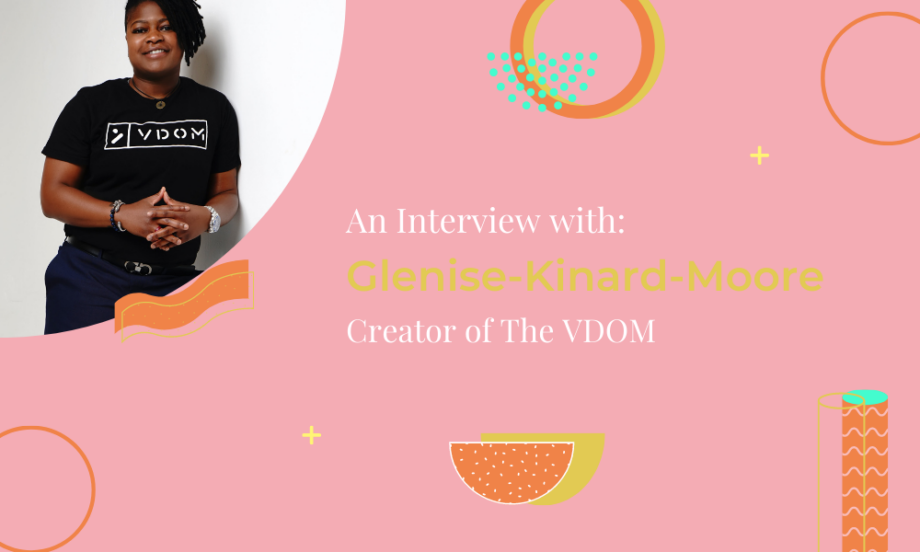The desire to have strap-on sex is hardly new. According to some very cool history nerds on Reddit, it may, in fact, be thousands of years old. But while strap-ons themselves have certainly improved (Silicone dildos! Comfy harnesses! O-rings!), strap-ons can still be a bit awkward. There are often buckles and straps to deal with. And even the newer underwear-style harnesses have to be shimmied into and outfitted with an (ever erect) dildo at some point. This can make strap-on sex very location specific; it isn’t so great for clandestine encounters in semi-public places.
As a strap-on lover, Glenise Kinard-Moore, founder of SkiiMoo Tech and creator of The VDOM, wanted to change that. And, when she set out to build an app-controlled strap-on alternative, she did it with other LGBTQ women in mind.
“I was sitting around with friends and was, like ‘Wouldn’t it be cool to have this type of product?’ I wanted something where my wife and could go out and have sex in an alley or in the car,” Kinard-Moore said.
Read: A Beginner's Guide to Strap-On Sex
As luck would have it, Kinard-Moore also has a strong background in tech as a seasoned information security professional and an ambitious tech nerd. So, after putting significant thought and research into the product and its potential, she jumped into making it a reality.
Although Kinard-Moore is one of a growing number of female founders creating products aimed at helping people have better, more fulfilling sex, The VDOM sits in a very unique space.
“There’s been a revolution of women starting to get into the industry, but many of them were focused on clitoral stimulation,” Kinard-Moore said. “I wanted to come in and shake things up with this product. People still like penetration. The G-spot is a real thing!”
So what, exactly, is The VDOM? It’s a strap-on, sure, but it’s actually better described as a wearable genital prosthetic. This silicone “cyber penis” snaps securely and easily into a pair of specially-designed underwear and connects to an app, allowing for spontaneous erections - and sex - anytime and anywhere the user wants.
At first, Kinard-Moore saw The VDOM as a better option for lesbian strap-on lovers like herself; it was also a clear fit for trans people who wanted to wear something comfortable, functional and gender-affirming for long periods of time.
After more research, however, Kinard-Moore realized there was another important demographic this product could reach: people with erectile dysfunction or physical disabilities.
“We did not realize how many heterosexual men with erectile dysfunction use strap-ons until we started the research,” Kinard-Moore said. “That’s why we call this a lifestyle product instead of a sex toy.”
So, back to the awkwardness of strap-ons for a minute. For people with penises that are no longer able to achieve an erection, that awkwardness takes on a whole new dimension. As a wearable strap-on that can go from flaccid to erect at the push of a button, the VDOM acts much more like a penis by allowing for the kind of spontaneous sex that just isn’t possible with typical strap-ons. In other words, it’s another option - one beyond medication or surgery - that helps men with physical limitations that prevent erection regain some of the sexual freedom they’ve lost. (And just to note, it looks remarkably realistic as well.)
Read: Strap-On Wearing for Cis-Men
A 2019 review found that more than 76% of men experience erectile dysfunction in their lifetimes. The prevalence of gender-affirming surgery is also growing by leaps and bounds in the trans community.
In other words, the market for a product like this definitely exists, but that doesn’t mean the growth of the company hasn’t been without challenges.
After raising more than $100,000 from family and friends, Kinard-Moore has also had to tap into her own funds to keep the project going. In other words, she’s faced the same barriers to raising capital so many femtech founders (and Black female founders) face when it comes to funding, particularly those who run companies that cater to sexual health.
“Explaining to heterosexual white men funders why this product needs to exist is a challenge,” Kinard-Moore said. “Every time we get close to having someone interested, they start to feel uncomfortable about what the product is.”
COVID-19 has also made producing a product more challenging. Like many companies in the space, The VDOM has faced supply chain pricing snags and shipping issues. When we spoke, Kinard-Moore was just sorting out issues with packaging due to a paper shortage.
But Kinard-Moore is pushing forward with fulfilling pre-orders, which she notes are going out to some very loyal and patient fans of the idea.
“I will say that our consumers, our pre-orders, they’ve held strong with us,” Kinard-Moore said.
The enthusiasm and support may stem from the fact that marginalized groups are not well-represented in sextech. That’s something she’d like to change. Not only is The VDOM designed to appeal to some key groups that are often overlooked in tech development, but it also aims to gather data about how people use the product.
“For trans people, there’s very little data about what they want and need. We have an opportunity to create better knowledge around their sexual activity and needs,” Kinard-Moore said.
Read: Reproductive Health Care for Trans People
Kinard-Moore’s background in information security doesn’t hurt here, especially in an age where digital privacy has become so important. The VDOM is set up for top security, including two-factor authentication, encryption at every field in the app and the separation of personal information from user information into separate databases.
“I always tell my team we never want to be like Ashley Madison,” Kinard-Moore said.
So what’s next for The VDOM? Kinard-Moore says she’s currently finalizing the first pre-orders of the product, and expects to be able to reopen ordering soon. She also has upcoming versions of the product on the go, including adding stimulation for the product’s wearer and creating a device with sensors that can react to the wearer’s body.
It sounds pretty cool, right? If inclusive sextech is the future, we’re in.
Want to learn more about The VDOM or sign up for their waitlist? You can do that here.
Tara Struyk is a co-founder and the editor-in-chief of Kinkly.com. She’s a content creation and management executive with 15 years of experience working in online media. As a writer, her work has appeared in dozens of publications, including Forbes, Glamour, MensHealth and Investopedia.
Tara is currently the VP of Content at Janalta.com, where she leads the editorial department and directs content production for a diverse portfolio of websites in niche verticals. She has launched several...




